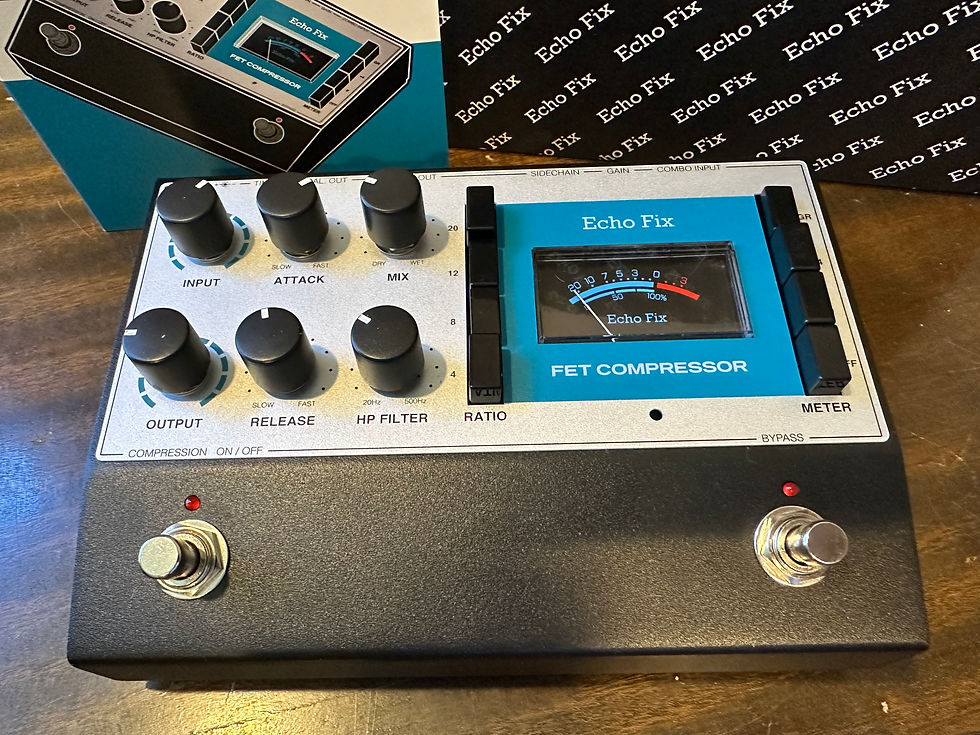Lusithand Alma MKIII Compressor Review
- Compressor Guy
- Jun 7
- 3 min read
LusitHand Devices is a London-based boutique builder specializing in high-quality bass guitar pedals and onboard preamps. I previously reviewed the original Lusithand Alma compressor here and also the later MKII version here. When I learned there was a third version coming I knew I wanted to try it. I am a big fan of the Lusithand Alma. It's a bass compressor pedal praised for its punch and dynamic clarity.

Core functionality remains the same on the MKIII so read my reviews of the previous editions for an in-depth look at the compressor design and attributes. New to the MKIII are two new pieces of functionality.
The first is a Fast/Slow attack switch gives you control over how quickly the compression responds. Flip the switch on the face of the pedal up for slow attack and down for faster attack. I asked Nuno Maio, the builder, about the differences in timing between slow and fast and he responded with:
I have no idea. adjust things by ear and, once I'm happy, leave it at that.
Well that answer works for me. Nuno has a good ear. My preference is for the slow attack in general. The Fast/Slow attack is a welcome addition in my opinion. It's easy to use and easy to switch. A slower attack speed on a compressor allows transients—the initial “spikes” of a sound—to pass through before compression kicks in. This can be desirable for several reasons, especially with instruments like bass guitar. A slower attack: • Preserves punch by letting the initial impact cut through before compression softens the rest. This can help keep your tone alive and dynamic. • Mimics how our ears naturally perceive dynamics—compressed by not squashed.
• Allows things like finger noise or pick attack to remain audible, which can add clarity and definition.
• Can help an instrument sit on top of a mix without just being louder. A slower attack helps maintain that edge by allowing some of the initial transient through before the signal is squashed.

The second new piece of functionality is –6 dB input attenuator switch which is ideal for high-output basses to avoid overloading the circuit. The Alma compressor already has plenty of headroom and an internal voltage doubler (9-18 Voltage in can = up to 36 volts of headroom). Headroom is not an issue. But now you can attenuate the input if you desire.
Technically Nuno had to increase the output gain to compensate for the -6db attenuation, which will, inevitably slightly increase the noise floor (the more gain the more noise) but the noise levels are still really good. Probably wouldn't even notice much of a differenc in noise floor.
The price remains virtually unchanged though the Euro to Dollar does fluctuate.
If I were to publish a list of top compressor picks I'm sure the Alma Comp would hold a spot. Excellent device and now even better.
The latest keeps the functionality and all that was good about the previous two editions, now with a couple of nice additions.
Is it worth upgrading if you already have an Alma? In my opinion, if you are a user of the original Alma Comp I'd splurge on MKIII. Between the new functionality of the MKII and now the MKIII I think its worth it for sure. A move from MKII to MKIII is less compelling.
Check it out.
Pros:
• All of what makes the prior version stellar is still here
• The attack timing switch is a nice and useful addition
• Sound
• Overall functionality
• Quality
• Clean blend and tone control
• Tone mojo
• Gain reduction LED
Cons:
• Not a whole lot to complain about, really
• A bit boring looking
Lusithand.com
See all compressor pedal reviews.



